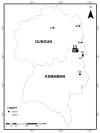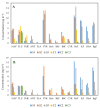Exposure to Particulate PAHs on Potential Genotoxicity and Cancer Risk among School Children Living Near the Petrochemical Industry
- PMID: 33806616
- PMCID: PMC7967639
- DOI: 10.3390/ijerph18052575
Exposure to Particulate PAHs on Potential Genotoxicity and Cancer Risk among School Children Living Near the Petrochemical Industry
Abstract
This study aimed to assess the association of exposure to particle-bound (PM2.5) polycyclic aromatic hydrocarbons (PAHs) with potential genotoxicity and cancer risk among children living near the petrochemical industry and comparative populations in Malaysia. PM2.5 samples were collected using a low-volume sampler for 24 h at three primary schools located within 5 km of the industrial area and three comparative schools more than 20 km away from any industrial activity. A gas chromatography-mass spectrometer was used to determine the analysis of 16 United States Environmental Protection Agency (USEPA) priority PAHs. A total of 205 children were randomly selected to assess the DNA damage in buccal cells, employing the comet assay. Total PAHs measured in exposed and comparative schools varied, respectively, from 61.60 to 64.64 ng m-3 and from 5.93 to 35.06 ng m-3. The PAH emission in exposed schools was contributed mainly by traffic and industrial emissions, dependent on the source apportionment. The 95th percentiles of the incremental lifetime cancer risk estimated using Monte Carlo simulation revealed that the inhalation risk for the exposed children and comparative populations was 2.22 × 10-6 and 2.95 × 10-7, respectively. The degree of DNA injury was substantially more severe among the exposed children relative to the comparative community. This study reveals that higher exposure to PAHs increases the risk of genotoxic effects and cancer among children.
Keywords: DNA damage; children; industry; polycyclic aromatic hydrocarbons (PAHs).
Conflict of interest statement
The authors declare no conflict of interest.
Figures




Similar articles
-
The Influence of Environmental Polycyclic Aromatic Hydrocarbons (PAHs) Exposure on DNA Damage among School Children in Urban Traffic Area, Malaysia.Int J Environ Res Public Health. 2022 Feb 15;19(4):2193. doi: 10.3390/ijerph19042193. Int J Environ Res Public Health. 2022. PMID: 35206377 Free PMC article.
-
Cumulative health risk assessment of halogenated and parent polycyclic aromatic hydrocarbons associated with particulate matters in urban air.Ecotoxicol Environ Saf. 2015 Mar;113:31-7. doi: 10.1016/j.ecoenv.2014.11.024. Epub 2014 Dec 5. Ecotoxicol Environ Saf. 2015. PMID: 25483369
-
Source Identification and Health Risk Assessment of Polycyclic Aromatic Hydrocarbon-Enriched PM2.5 in Tangshan, China.Environ Toxicol Chem. 2020 Feb;39(2):458-467. doi: 10.1002/etc.4618. Epub 2019 Dec 27. Environ Toxicol Chem. 2020. PMID: 31622510
-
Children environmental exposure to particulate matter and polycyclic aromatic hydrocarbons and biomonitoring in school environments: A review on indoor and outdoor exposure levels, major sources and health impacts.Environ Int. 2019 Mar;124:180-204. doi: 10.1016/j.envint.2018.12.052. Epub 2019 Jan 14. Environ Int. 2019. PMID: 30654326 Review.
-
Source apportionment and toxicity assessment of PM2.5-bound PAHs in a typical iron-steel industry city in northeast China by PMF-ILCR.Sci Total Environ. 2020 Apr 15;713:136428. doi: 10.1016/j.scitotenv.2019.136428. Epub 2020 Jan 13. Sci Total Environ. 2020. PMID: 32019009 Review.
Cited by
-
The Intra- and Extra-Telomeric Role of TRF2 in the DNA Damage Response.Int J Mol Sci. 2021 Sep 14;22(18):9900. doi: 10.3390/ijms22189900. Int J Mol Sci. 2021. PMID: 34576063 Free PMC article. Review.
-
The Comet Assay as a Tool in Human Biomonitoring Studies of Environmental and Occupational Exposure to Chemicals-A Systematic Scoping Review.Toxics. 2024 Apr 5;12(4):270. doi: 10.3390/toxics12040270. Toxics. 2024. PMID: 38668493 Free PMC article.
-
Aryl hydrocarbon receptor-kynurenine axis promotes oncogenic activity in BCP-ALL.Cell Biol Toxicol. 2023 Aug;39(4):1471-1487. doi: 10.1007/s10565-022-09734-0. Epub 2022 Jun 10. Cell Biol Toxicol. 2023. PMID: 35687267 Free PMC article.
-
Genetic and epigenetic modulations in toxicity: The two-sided roles of heavy metals and polycyclic aromatic hydrocarbons from the environment.Toxicol Rep. 2024 May 4;12:502-519. doi: 10.1016/j.toxrep.2024.04.010. eCollection 2024 Jun. Toxicol Rep. 2024. PMID: 38774476 Free PMC article. Review.
-
Exposure assessment and carcinogenic risk characterization of industrial chemical emissions in incheon, South Korea.Sci Rep. 2025 Jul 14;15(1):25393. doi: 10.1038/s41598-025-11736-x. Sci Rep. 2025. PMID: 40659750 Free PMC article.
References
-
- Iwegbue C.M.A., Obi G., Uzoekwe S.A., Egobueze F.E., Odali E.W., Tesi G.O., Nwajei G.E., Martincigh B.S. Distribution, sources and risk of exposure to polycyclic aromatic hydrocarbons in indoor dusts from electronic repair workshops in southern Nigeria. Emerg. Contam. 2019;5:23–30. doi: 10.1016/j.emcon.2018.12.003. - DOI
-
- Sulong N.A., Latif M.T., Sahani M., Khan M.F., Fadzil M.F., Mohd Tahir N., Mohamad N., Sakai N., Fujii Y., Othman M., et al. Distribution, sources and potential health risks of polycyclic aromatic hydrocarbons (PAHs) in PM2.5 collected during different monsoon seasons and haze episode in Kuala Lumpur. Chemosphere. 2019;219:1–14. doi: 10.1016/j.chemosphere.2018.11.195. - DOI - PubMed
Publication types
MeSH terms
Substances
LinkOut - more resources
Full Text Sources
Other Literature Sources
Medical

